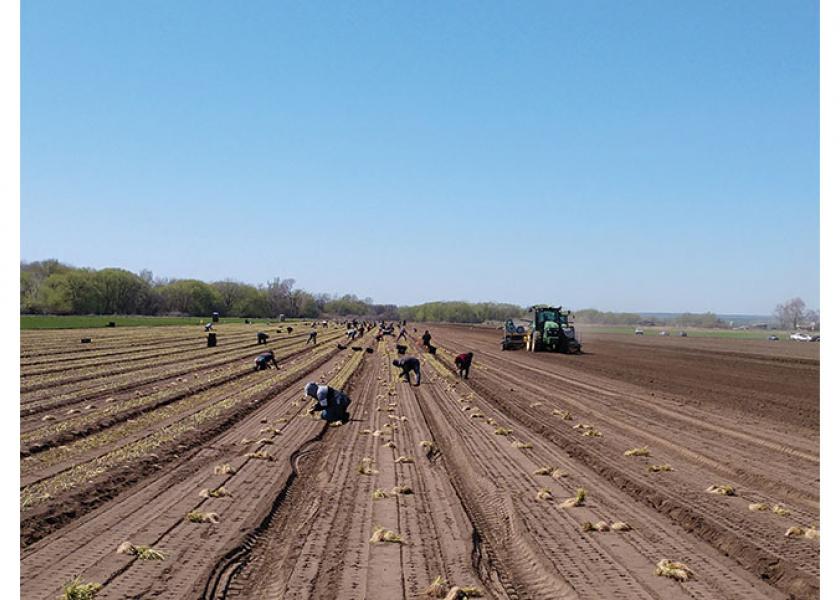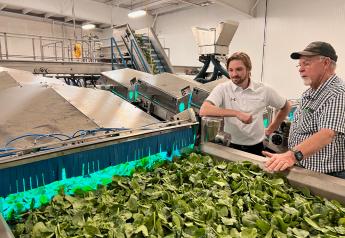Onion market flush with product, but fewer outlets

There are plenty of onions available at the end of April after six weeks of the new coronavirus COVID-19 pandemic, and the results were apparent in the latest prices.
As of April 24, 50-pound sacks of yellow grano onions from Mexico were $7-8 for colossal and jumbo sizes, and $9-10, mediums.
That represented a reversal from only two months earlier, when the same product, from the same origin, was $8-10 for colossal; $7-8, jumbos; and $5-7.50, mediums.
By the same date in 2019, Mexico had finished and the same product from Texas’ Lower Rio Grande Valley was fetching $16-18 for super-colossal; $15-17, colossal; $12-15, jumbo and $12-14, medium.
This year onions were available everywhere, including from storage — which, suppliers note, normally would be gone by early May. Meanwhile, spring deals were pumping out fresh product in Texas and California, with the Vidalia season underway in Georgia.
The difference, grower-shippers said, was foodservice demand: Coronavirus-forced restaurant shutdowns, along with stay-at-home orders in many states, had shut off demand from nearly half of the onion market.
“It’s just kind of an interesting situation,” said Dan Borer, general manager of the Walla Walla, Wash., office of Greencastle Pa.-based Keystone Fruit Marketing Inc.
“If we take one thing and look at the storage crop in the Northwest, everybody thought three months ago we’d be cleaned up by today. Now, you’re sitting here with people saying they will have supply until June and don’t know how they’re going to get rid of it. You cut out the institution/restaurant sales, plus processing has slowed down, and there’s a bunch of extra onions out there that don’t have a home.”
Related content to Georgia produce
Growers reported good yields and quality in their crops, but uncertainty had cast a pall over what they could do with it.
“In Wisconsin, we experienced another wet fall harvest, but it didn’t deter our local growers’ onion crop as yields were excellent,” said Tony Huizenga, national sales manager/onion buyer with Friesland, Wis.-based Alsum Farms & Produce.
“Wisconsin was one of the few growing regions that stocks on hand for the 2019 crop were higher than the previous year.”
However, there remained much uncertainty in the foodservice industry, and it had become a challenge among suppliers to come up with an effective marketing plan for their onions, “since they don’t know how long their customers who operate restaurants will be closed or operate with limitations,” Huizenga said.
All Alsum’s onion business is retail, Huizenga noted, and sales were brisk, but they had “leveled off a bit” in April, he said.
“Prices are stabilizing with the Northwest cleaning up and the Southwest kicking into full gear,” he said.
“Rain always plays a big part in the Southwest this time of year, since all of their onion is crop is harvested and sold right away.”
Rainy weather and hail in April delayed harvests periodically for some Vidalia onion growers, and some reported damage to their crops of 10% to 20%, but harvesting was back to normal by the last week of the month.
Onion sales had grown by 6% in dollars and 5% in sales volume in a 52-week period leading up to the pandemic, and that applied to all varieties, said Rachel Atkinson-Leach, brand and category manager with Bancroft Wis.-based Russet Potato Exchange.
Related content to Vidalia Onions
She noted conventional onions saw dollar growth of almost 8%, while organic showed double-digit growth of 13%.
Specialty onions, which comprise 15% of the category, showed “little growth” over the last year, Atkinson-Leach said, noting that both bagged and bulk onions showed growth of 6%, year-on-year.
Five-pound onion bags saw the highest growth at 11%-percent, and fresh prep onions saw flat sales over the same time, she said.
“Markets have been very volatile and, with import onions having longer and longer seasons, it’s putting downward pressure on the total market, which isn’t helping us as growers,” Atkinson-Leach said.
Keystone’s Borer said he couldn’t predict how, or whether, the onion business would return to normal.
“People’s shopping habits have changed,” he said.
“With uncertainty in the business, it’s hard to get a bead on where you put your efforts. The major retailers — nobody can get a bead on what is happening week to week, because there is no set new reality. The sad part is that it’s going to cause people to let go of some product. It’s sad, but it’s happening already in small places.”
The only certainty seemed to be supplies, said Greg Yielding, chief executive with the Greeley, Colo.-based National Onion Association.
“Everybody’s got plenty, and you’ve got spring onions coming off and storage onions that would have gone to foodservice that obviously didn’t go,” he said.







